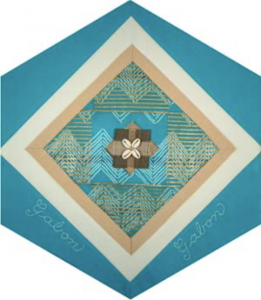Gabon

The Block
Materials donated by Henriette Ognaligui-Gauthier were used to make the block representing Gabon. Four cowrie shells rest atop perpendicular layers of woven raffia at the centre of this block. Once used as a form of currency, not only in Africa, but throughout the world, cowrie shells were believed to have the power of fertility and are currently used as a form of decoration. Raffia––the grassy fibre extracted from palm tree leaves––is an important material in Gabon that is used not only to weave traditional mats and baskets, but also in the making of costumes worn during rituals and as adornment for celebratory or ceremonial masks. The block’s cotton background, framed by gold trim, is a modern Gabon fabric featuring a geometric print with gold overlay.
Cultural Profile
Gabon, formerly known as ‘French Equatorial Africa,’ is a small country situated on the central west coast of Africa. Its name is derived from the Portuguese, who called the area “Gabao” (hooded cloak) because of the shape of the River Mbe’s estuary. Gabon is wealthy in mineral resources, including large deposits of iron ore that are considered to be among the world’s richest. Since production has meant less pressure on trees as a source of revenue, nearly three-quarters of the land remains covered by dense rain forest. The country’s economy does, however, depend to some extent on forest resources and Gabon is the world’s largest producer of okoume, a softwood that is used to make plywood. Gabon is also the site of the famed Albert Schweitzer Hospital, which was established in 1913 by the missionary-physician. Schweitzer devoted a large part of his life to Gabon and eventually won the Nobel Peace Prize for his work there.
Gabon’s ethnically diverse population is comprised of approximately 40 different groups, which are subdivided into ten large tribes. Bakas (once known as Pygmies) are believed to be the country’s original inhabitants, but currently only a few thousand remain. Most Gabonese belong to the Fang, Mpongwe, M’Bete or Puna groupings. The official language is French, understood by almost everybody, although many African tongues, including Fang, are spoken by specific tribes. Gabonese are noted for their hospitality, openness and respect of differences. A drink of palm wine or whisky is traditionally offered to visitors by the local chief, with a few drops poured on the house’s doorstep to honour the spirits of departed ancestors.
A good part of Gabon’s cultural life is derived from or influenced by France and, even though there are distinct regional differences, many similarities exist. Ancient traditions are still upheld, especially outside urban areas, where shamans (guérisseurs) are regularly consulted and offerings in forms of drink and food are made to forest spirits. Carved wooden masks––worn during festivals, celebrations and ceremonies revolving around birth, marriage and death––are central to all Gabonese tribal groups. Community songs and dances unite tribes in times of celebration or mourning and oral traditions are strong. Gatherings often last many days. The ceremony of Bwiti, originally a Fang initiation ritual, is practised in Gabon regardless of the participant’s ethnic origins. The ceremony includes playing the mugongo harp, and singing. The person being initiated eats iboga root, a substance that is said to allow him or her to communicate with his ancestors.The festivities last three days.
The Fang, in particular, are distinguished by epic tales known as mvet. Musicians half-tell, half-sing traditional stories and legends encompassing a complete cosmogony, while accompanying themselves on a harp-zither, which is also known as a mvet. Other popular instruments include the balafon (xylophone) and drums, which not only provide music, but also serve as a means of communication.
Some 1,000 Gabonese currently live in Canada. Most have settled in francophone areas of the country, such as Québec and New Brunswick because of their fluency in French.
Sponsor: Canadian Federation of University Women, Cornwall and area
